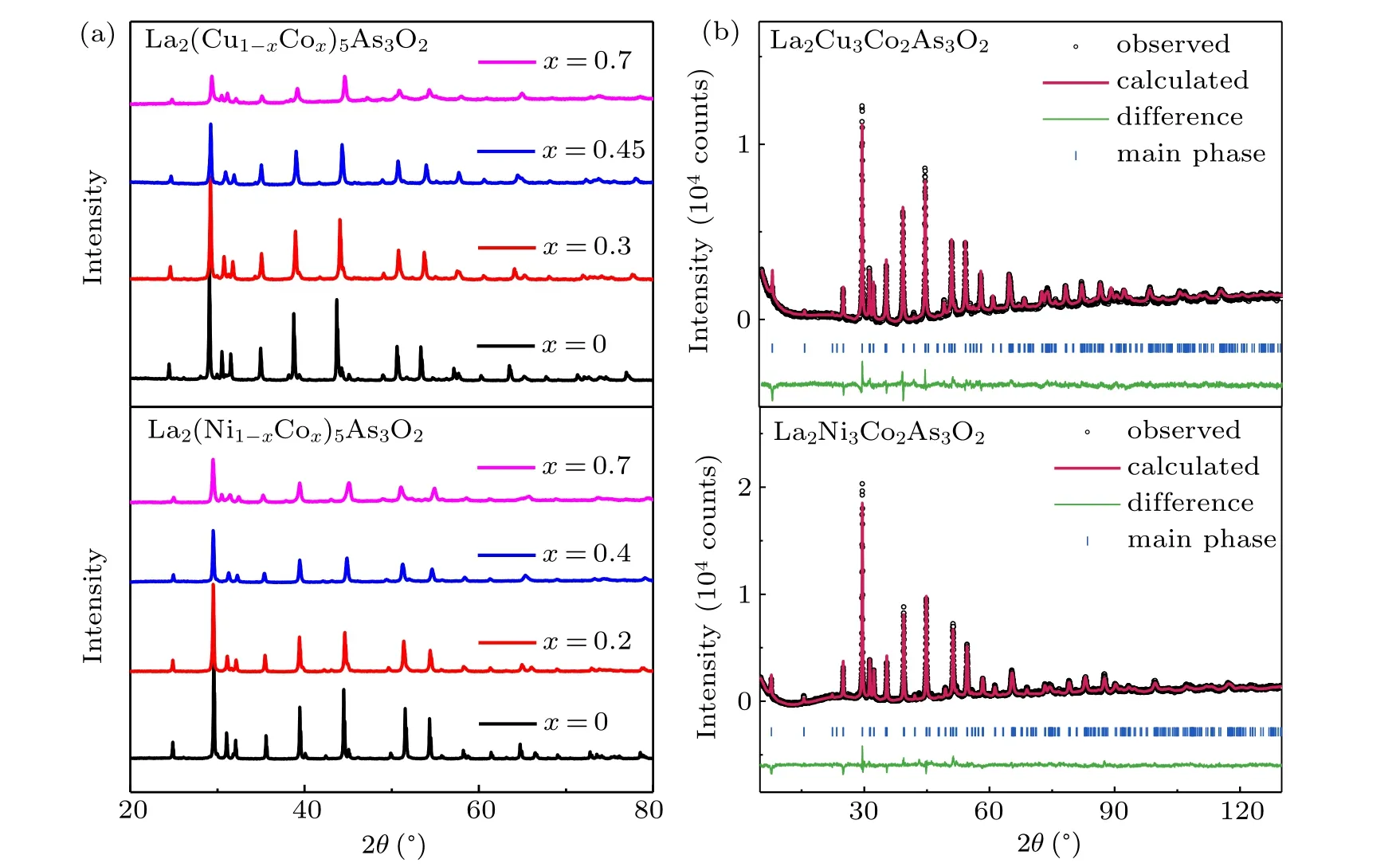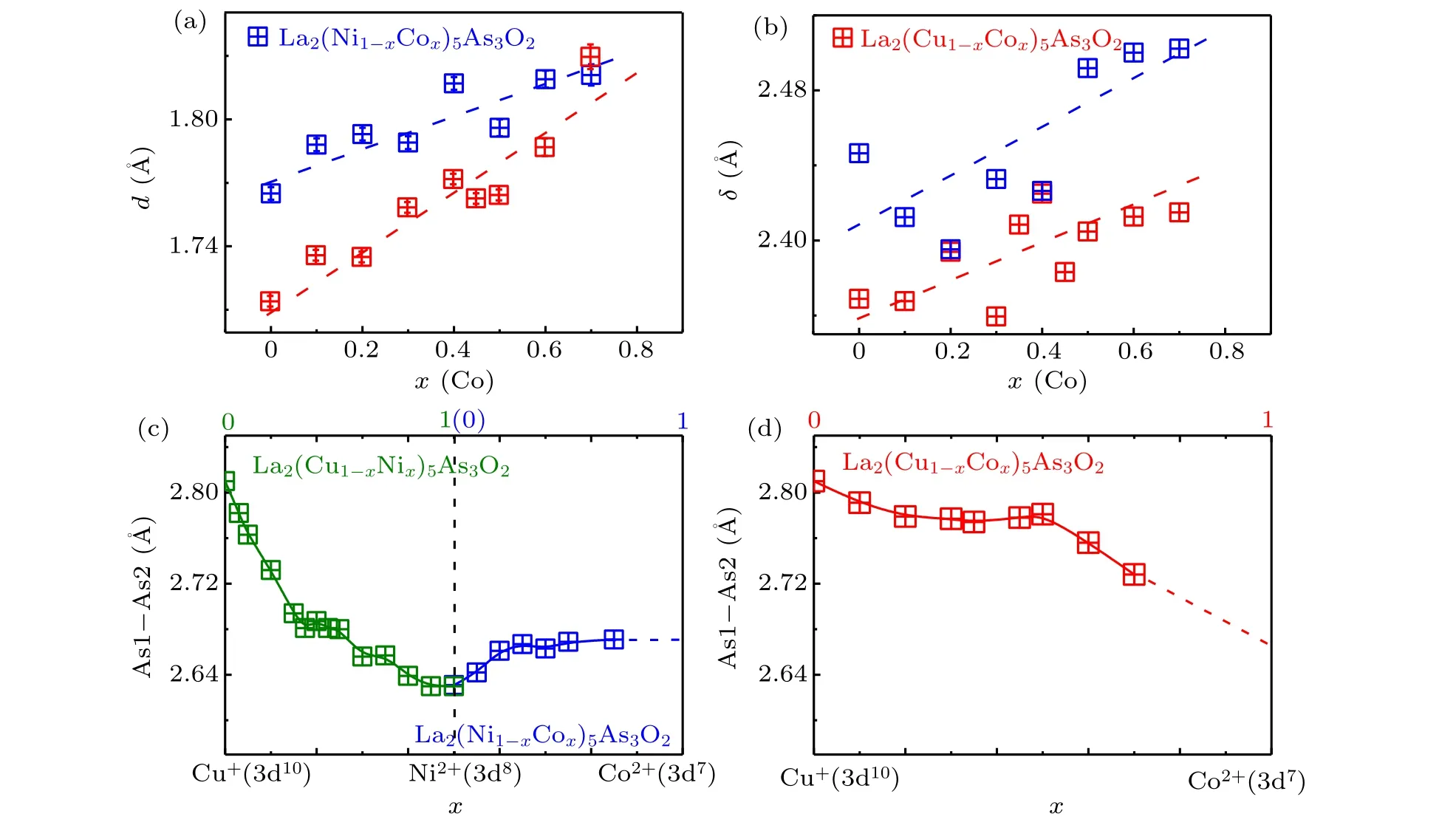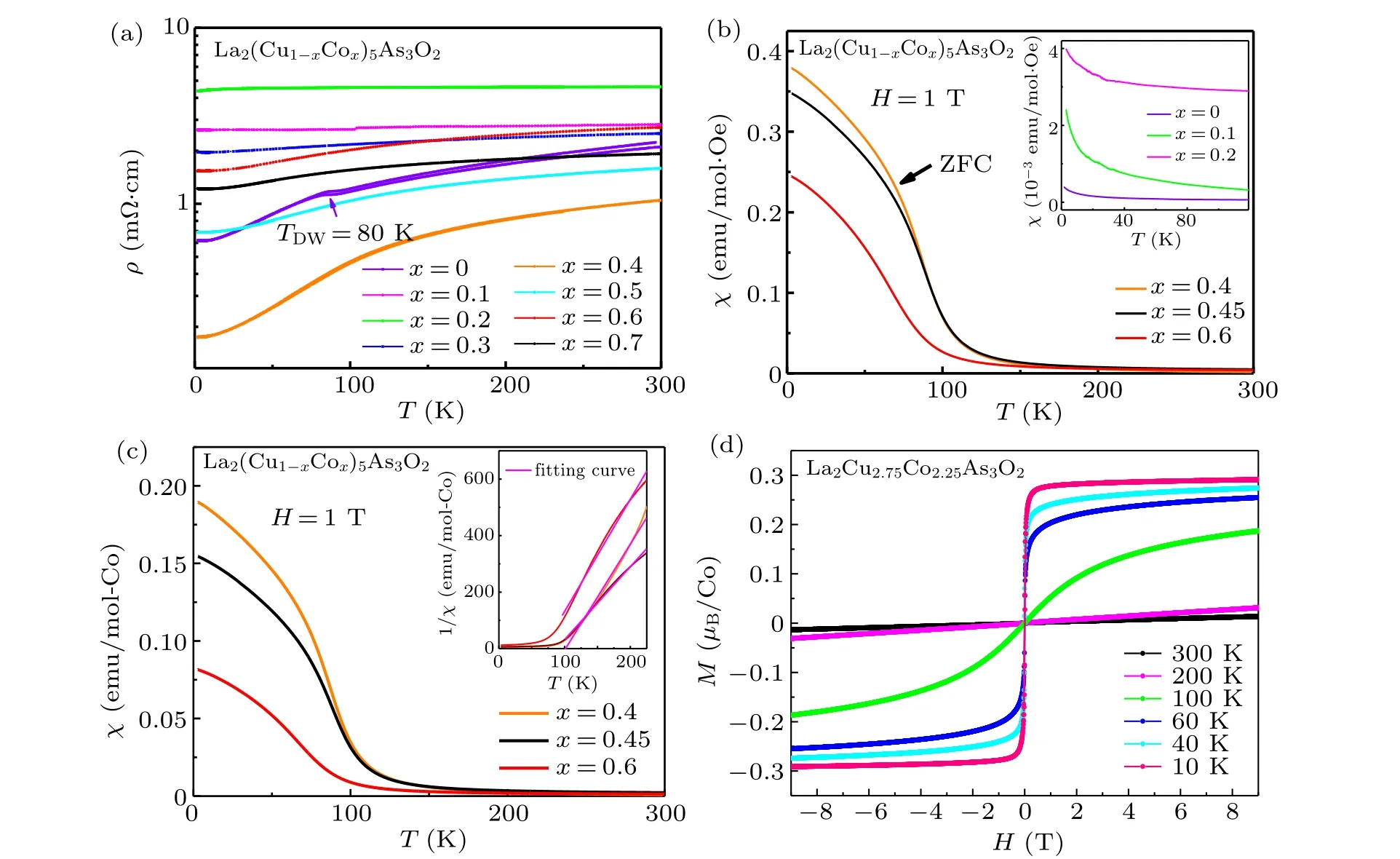Structural modulation and physical properties of cobalt-doped layered La2M5As3O2(M=Cu,Ni)compounds*
Lei Yang(楊蕾) Yan-Peng Song(宋艷鵬) Jun-Jie Wang(王俊杰)Xu Chen(陳旭) Hui-Jing Du(杜會(huì)靜) and Jian-Gang Guo(郭建剛)
1Key Laboratory for Microstructural Material Physics of Hebei Province,School of Science,Yanshan University,Qinhuangdao 066004,China
2Beijing National Laboratory for Condensed Matter Physics,Institute of Physics,Chinese Academy of Sciences,Beijing 100190,China
3University of Chinese Academy of Sciences,Beijing 100049,China
4Songshan Lake Materials Laboratory,Dongguan 523808,China
Keywords: crystal structure,As-As covalent bond,transport property
1. Introduction
Discovery of high-temperature superconductivity(SC)of cuprates,[1-3]iron pnictides,[4,5]and iron selenides[6-10]has brought out huge advances in condensed matter physics and material sciences. Typical structure of both iron-based superconductors is a layered form, where the spacer layers are ionic [La2O2]2+/Ba2+/K+and the functional layers are antifluorite type[Fe2X2]2-(X=P/As or S/Se/Te).The interesting properties like superconducting transition temperature(Tc),[11]quantum critical point,[12]nematic phase,[13]and magnetic fluctuation[14]are intimately determined by the geometry and electron counting of the latter one.
In well-documented reports, chemical doping in the spacer or functional layer can effectively influence the states of[Fe2X2]2-,Tc,and superconducting property.[15,16]For example, in ThCr2Si2-type BaFe2As2, partial replacing divalent Ba2+with monovalentA+ions (A= alkali metal) leads to hole-doping superconductors exhibiting dome-likeTc.[5]Alternately, substituting Fe2+with Co2+/Ni2+cation[17,18]or As3-with P3-anion[12]can induce electron-doped superconductors with similar dome-likeTcand many unexpected properties. In terms of crystallography, we can see there are distinct evolutions of crystal structure upon doping. That is, the in-plane latticeashrinks (expands)and thec-axis expands (shrinks) in hole (electron)-doped Ba1-xAxFe2As2,[19-21]which is viewed as competition of intra-layer deformation and interlayer Coulomb attraction due to accumulation of charge in the [Fe2X2]2-layers.[22]Once the excess holes are introduced into the[Fe2X2]2-layers,the Fe-Xbond length andX-Fe-Xangle are decreased, leading to an in-plane contraction. Meanwhile, the Coulomb attraction between the positive space layers and negative charged[Fe2X2]2-layer weakens,and the expansion ofc-axis ensues.
TheLn2(Cu1-xNix)5As3O2(Ln=La, Pr, Nd)is the first CuAs-based superconductor reported by our group.[23]It possesses a typical layered structure that is consisted of spacer layer[La2O2]2+and functional subunit[M5As3]2-(M=Cu,Ni, Co) containing strong As-As covalent bond alongcaxis.[24,25]For the end-memberRe2Ni5As3O2(Re=La, Ce,Sm),[26]it exhibits a structural phase transition from tetragonal(I4/mmm)to orthorhombic(I/mmm)symmetry,and does not change into superconductors at low temperature. The solidsolutions ofLn2(Cu1-xNix)5As3O2exhibit complex change in structure, whereaincreases andcdecreases asx <0.4, and thenadecreases andcincreases asx >0.4. At the same time,the As-As bonding length shrinks from 2.81 ?A to 2.63 ?A,leading to a dome-likeTcwith the highestTcatx=0.4. Since the As-As covalent bond can accumulate or release excess electrons, the empirical rule obtained from ThCr2Si2-type compounds seems not to be accurate enough to describe the structural change in the layered compounds.
In this work, we prepare two series of solid solutions of La2(M1-xCox)5As3O2(M=Cu,Ni)(x=0-0.7)and systematically investigate the structural change and physical property. It is found that the As-As bond length only slightly changes (±2%), differing from large shrinkage of that in La2(Cu1-xNix)5As3O2.[23]Meanwhile, we observe that the Co-doping induces monotonous change inaandcunlike the anomalous kink of La2(Cu1-xNix)5As3O2. In addition,La2(Cu1-xCox)5As3O2(x=0-0.7)exhibits a phase transition from paramagnetism to ferromagnetism as the Co content increases above 0.4. While La2(Ni1-xCox)5As3O2(x=0-0.7)samples only show paramagnetism, and the structural transition from tetragonal to orthorhombic phase is suppressed. We discuss the structural evolution and the lack of superconductivity from the key aspect of As-As covalent bonding state.
2. Experimental details
Polycrystalline samples of La2(M1-xCox)5As3O2(M=Cu, Ni) (x=0-0.7) were synthesized by conventional solidstate reactions. The binary precursors LaAs and Cu3As,NiAs,Co2As were pre-synthesized by reacting La filings,Cu/Ni/Co powder and As powder at 1000 K for 20 h. Then, the powders of LaAs,Cu3As,NiAs,Co2As,La2O3,Ni,and Cu were weighted according to the desired ratio, ground, and pelleted under a pressure of 50 MPa in an argon-filled glove box with an O2and H2O content below 1 ppm. The pellet was loaded into an Al2O3crucible,and then sealed into an evacuated silica tube, which was heated at 150 K, hold for 40 h, and then furnace-cooling to room temperature.
Powder x-ray diffraction (PXRD) patterns of the obtained samples were collected using a Panalytical diffractometer with CuKα(λ=1.5408 ?A)radiation equipped with a lowtemperature cryostat. Rietveld refinement of the PXRD pattern was performed by Fullprof software suites.[27]The electrical resistivity (ρ)was measured through the standard fourwire method in the physical property measurement system(PPMS, Quantum Design). The dc magnetic properties were characterized using a vibrating sample magnetometer(PPMS,Quantum Design).
3. Results and discussion
Figure 1(a) shows the PXRD patterns of the selected La2(M1-xCox)5As3O2(M=Cu,Ni)samples for clarity.There are no obvious impurity peaks in the whole pattern, indicating that the synthesized samples are homogeneous and almost pure phase. All diffraction peaks exhibit monotonous shift with increasing the content of Co. Meanwhile, all the peaks can be indexed with a unit cell of tetragonal symmetry. We determined the crystal structure of pure La2Cu5As3O2and La2Ni5As3O2phases and reported them in Refs.[23,26].Therefore, we can refine the whole PXRD pattern of two series of Co-doped La2Cu5As3O2and La2Ni5As3O2samples based on the above structure. The representative profiles are plotted in Fig. 1(b). The refinements of both patterns of La2Cu3Co2As3O2and La2Ni3Co2As3O2smoothly converge intoRp=1.92%,Rwp=2.76% andRp=1.78% andRwp=2.43%, respectively. Here we think that the Cu/Ni atoms are random substituted by the Co ions without changing the structural symmetry. Meanwhile,the Co substitution of Cu(Ni)is more likely to be hole-doping due to two(one)fewer 3d electrons according to the results in literatures.[28,29]
The crystal structure of La2M5As3O2(M= Cu, Ni,Co) is drawn in Fig. 2(a). It can be seen that functional[M5As3]2-subunit and fluorite-type[La2O2]2+layers are alternately stacked along thec-axis. In a [Cu5As3]2-subunit, theM1 atoms are separated by a centralM2 plane and the As1-As2 are connected by the covalent bond with length of 2.81 ?A.The bonding details are shown in Fig.2(b).The Co-content dependent unit cell parameters are summarized and plotted in Figs. 2(c) and 2(d). The data of La2(Cu1-xNix)5As3O2are taken from Ref. [23] and shown as green square. We firstly examine the crystallographic parameters of La2(Ni1-xCox)5As3O2in the right panels of Figs. 2(c) and 2(d). Asxbelow the doping limit of 0.7, it is found that the lattice constantacontinuously decreases from 4.0691 ?A to 4.0162 ?A,however,thecinversely increases from 22.482 ?A to 22.972 ?A. The obtainedc/aratio linearly increases from 5.54 to 5.72, which perfectly falls into the extrapolated line of La2(Cu1-xNix)5As3O2. It again confirms the validation of the present experimental data. For the volume of a unit cell, it just slightly decreases from 372 ?A3to 370 ?A3. For the La2(Cu1-xCox)5As3O2, theamonotonously decreases from 4.1404 ?A to 4.0621 ?A, differing from that of La2(Cu1-xNix)5As3O2. While itsc-axis firstly keeps a constant and gradually saturates to be 23.0 ?A. Thec/aratio slightly increases from 5.54 to 5.66 and the volume linearly decreases from 391 ?A3to 379 ?A3. The shrinkage ofaand expansion ofcindicate that the Co-substitution is like hole-doping as suggested in hole-doped layered compounds of Ba1-xKxFe2As2[19]and Ba1-xNaxFe2As2.[20]In addition,the variations of lattice constants of two Co-doped cases are significantly different from those of La2(Cu1-xNix)5As3O2,in which thea,c, andc/aratio show non-monotonous changes and the highestTcperfectly occurs at the structural anomaly ofxNi=0.4.

Fig.1. (a)Powder XRD patterns of typical La2(M1-xCox)5As3O2(M=Cu,Ni)samples. (b)Rietveld refinement profiles of two representative samples of La2Cu3Co2As3O2 and La2Ni3Co2As3O2.

Fig.2. (a)Crystal structure of La2(M1-xCox)5As3O2 (M=Cu,Ni,Co). (b)Structure of[M5As3]2- subunit. (c)Lattice parameters a,c,c/a and volume of unit cell V of three series of samples. The data of La2(Cu1-xNix)5As3O2 are taken from Ref.[23]. The error bars are within the hollow squares.
In order to analyze the details of structural evolution,we first check the change in interlayer spacing (d) between[La2O2]2+layer and[M5As3]2-upon Co doping. It is found thatdlinearly increases within the limit of experimental error in Fig. 3(a). The increments ofdare 0.06 ?A and 0.13 ?A for La2(Ni1-xCox)5As3O2and La2(Cu1-xCox)5As3O2,respectively. At the same time,in Fig.3(b),the thickness(δ)of [La2O2]2+layers also increases, which can partially account for the trend of increase inc-axis. For the [M5As3]2-,the thickness equals to two times of As1-As2 bond length. In Fig. 3(c), we plot the variation of As1-As2 bond lengths of three systems. In Ni-doped La2Cu5As3O2, the length almost linearly decreases from 2.81 ?A to 2.63 ?A with a kink atx=0.4.However, as further lowering the number ofdelectrons from 3d8(Ni2+)to 3d7(Co2+),the As1-As2 bond length inversely increases slightly and then keeps a constant of 2.66 ?A. For Co-doped La2Cu5As3O2, the As1-As2 bond length slightly decreases from 2.81 ?A to 2.73 ?A accompanying a tiny kink atx=0.5,see Fig.3(d). From the above results,one can see that the expansion ofc-axis mainly comes from the increment of interlayer spacingdand thicknessδof [La2O2]2+layer because the thickness of[M5As3]2-changes little.


Fig.3.(a)and(b)Co-content dependent interlayer spacing d between[La2O2]2+layer and[M5As3]2-subunit,and thickness(δ)of[La2O2]2+layer. Dashed lines are guided to eyes. (c)and(d)As1-As2 bond lengths in three series of samples. The data of La2(Cu1-xNix)5As3O2 are taken from Ref.[23].

Fig.4. Physical properties of La2(Cu1-xCox)5As3O2. (a)Temperature-dependent electrical resistivity of La2(Cu1-xCox)5As3O2 (x=0-0.7)from 2 K-300 K.(b)Temperature-dependent magnetic susceptibility(χ)measured at H=1 T.Inset shows the χ(T)curves of x=0,0.1,and 0.2 samples. (c)χ(T)curves for per mol Co ion. Inset shows their inverse curves. Pinks lines are fitting curves as shown in the main text. (d)M-H loops of different temperatures.

Fig. 5. Physical property and structural phase transition of La2(Ni1-xCox)5As3O2. (a)-(b) Temperature-dependent electrical resistivity (ρ)and magnetic susceptibility (χ) measured at H =1 T. (c)-(d) (200) and (215) diffraction peaks of x=0.1 and x=0.6 samples measured from 10 K-300 K.(e)-(f)Temperature-dependent lattice constants of La2(Ni1-xCox)5As3O2 (x=0.1 and 0.6). For x=0.1,there is a phase transition evidenced by splitting of a-lattice parameters below 270 K.
Now we turn to investigate the transport property of La2(Ni1-xCox)5As3O2(x= 0-0.7). Figure 5(a) shows theρ(T) curves of all samples. It can be seen that all samples behave as a metal in the measured temperature range,and theρof the doped samples has increased by 1-2 orders of magnitude due to magnetic or disorder scattering. Another reason is that the As1-As2 covalent bond status changes the carrier concentration, and the synergistic effect enhances the resistivity. Figure 5(b)shows the magnetic susceptibilityχ(T)of La2(Ni1-xCox)5As3O2(x=0-0.7)withH=1 T.We can see that theχ(T)curves of all samples show paramagnetic behavior in the measured range. Meanwhile, with increasing the Co content,χ(T) gradually increases, the value is between 0.007 emu/mol·Oe and 0.025 emu/mol·Oe. Compared with theχ(T)of La2(Cu1-xCox)5As3O2,the high concentration of Co does not induce ferromagnetic phase transitions.
Since La2Ni5As3O2undergoes a structural phase transition from tetragonal (I4/mmm) to orthorhombic (I/mmm)symmetry at 270 K, we measured the PXRD pattern of La2(Ni1-xCox)5As3O2(x=0.1 and 0.6)from 300 K to 10 K so as to check the structural evolution upon Co doping. Figure 5(c) shows the temperature-dependent (200) and (215)diffraction peaks ofx=0.1 sample. We can see that the peaks(200)and(215)split into(200)/(020)and(125)/(215),respectively, as the temperature is lower than 270 K. It means that the sample undergoes a similar structural phase transition like La2Ni5As3O2. In Fig. 5(d), it can be seen that the (200) and(215)diffraction peaks ofx=0.6 sample shift towards higher angle without splitting with decreasing temperature, indicating that the phase transition has been suppressed. We use the orthogonal space groupI/mmm(No. 71) to index the PXRD pattern at 10 K. The lattice constants area0=4.0616(2) ?A,b0=4.0847(8) ?A, andc0=22.393(3) ?A. Figure 5(e) shows the temperature dependence of the lattice constants ofx=0.1 sample,wherea0andc0gradually decrease,andb0gradually increases and becomes saturated asTdecreases. Forx=0.6 sample,the lattice constantsaandcjust monotonously shrink during cooling,see Fig.5(f).
Let us briefly discuss the structural variation and physical property of La2M5As3O2(M=Cu,Ni)under Co doping. As previously reported doping behaviors in BaFe2As2, the substitution of Fe by Co/Ni/Cu with more 3d electrons leads to electron-type doping and the doping-dependent superconductivity can be scaled by the net carrier concentrations.[31]In the present work, the substitution of Co (3d7) into La2M5As3O2(M=Cu,Ni)should be hole-doped type,which is evidenced by the expansion ofab-plane and the shrinkage ofc-axis above. In La2Cu5As3O2, the Ni-doping can induce a domelikeTc; while the Co-doping only kills the DW-like transition and then induces ferromagnetic phase transitions~100 K rather than superconductivity. Furthermore,we found that the Co2+ions may exhibit unusual low-spin state (S=1/2) under this unique coordination. However, since the scattering lengths of Co2+and Cu+for x-ray are pretty close, we cannot unambiguously identify which site the Co2+ions preferentially occupy. For La2(Ni1-xCox)5As3O2, the Co-doping increases the As-As bond length a little bit from 2.63 ?A to 2.66 ?A,however,the increment is too small. It does not reach the As1-As2 bond length of La2(Cu1-xNix)5As3O2superconductor. Hence, the Co-doping does not induce superconductivity in the present work.
It is known that the Co-doping should not follow the rigid band model like the case of Co/Ni/Cu-doped BaFe2As2,[31,32]where partial induced electrons are localized around the dopant sites and do not contribute to the conductivity. Given the complex structural change like 40% kink in La2(Cu1-xNix)5As3O2and anisotropic change in thickness of[La2O2]2+layer and [M5As3]2-subunit, it is hard to reconcile the lattice variation with the simple electron counting.The dependence of physical properties on Co/Ni doping inLn2Cu5As3O2(Ln=La,Pr,Nd)should be more complicated due to the variation of As-As covalent bonding status. Detailed structural analyses and low-temperature measurements are needed to clarify the above two issues.
4. Conclusion
We have investigated the structure and low-temperature property of La2(M1-xCox)5As3O2(M=Cu,Ni;x=0-0.7). It is found that the doped Co ions induce simpler structural variation than those of La2(Cu1-xNix)5As3O2because the As-As bonding status barely changes. Furthermore, the Co-doping induces a paramagnetic to ferromagnetic phase transition asx >0.4 in La2(Cu1-xCox)5As3O2and suppresses the structural phase transition atx=0.6 in La2(Ni1-xCox)5As3O2.Unfortunately,all the doped samples are non-superconductive in the temperature range of 2-300 K. From the view of As-As bond,it demonstrates that the bonding states could determine the crystal evolutions and influence the transport property.
- Chinese Physics B的其它文章
- Projective representation of D6 group in twisted bilayer graphene*
- Bilayer twisting as a mean to isolate connected flat bands in a kagome lattice through Wigner crystallization*
- Magnon bands in twisted bilayer honeycomb quantum magnets*
- Faraday rotations,ellipticity,and circular dichroism in magneto-optical spectrum of moir′e superlattices*
- Nonlocal advantage of quantum coherence and entanglement of two spins under intrinsic decoherence*
- Universal quantum control based on parametric modulation in superconducting circuits*

